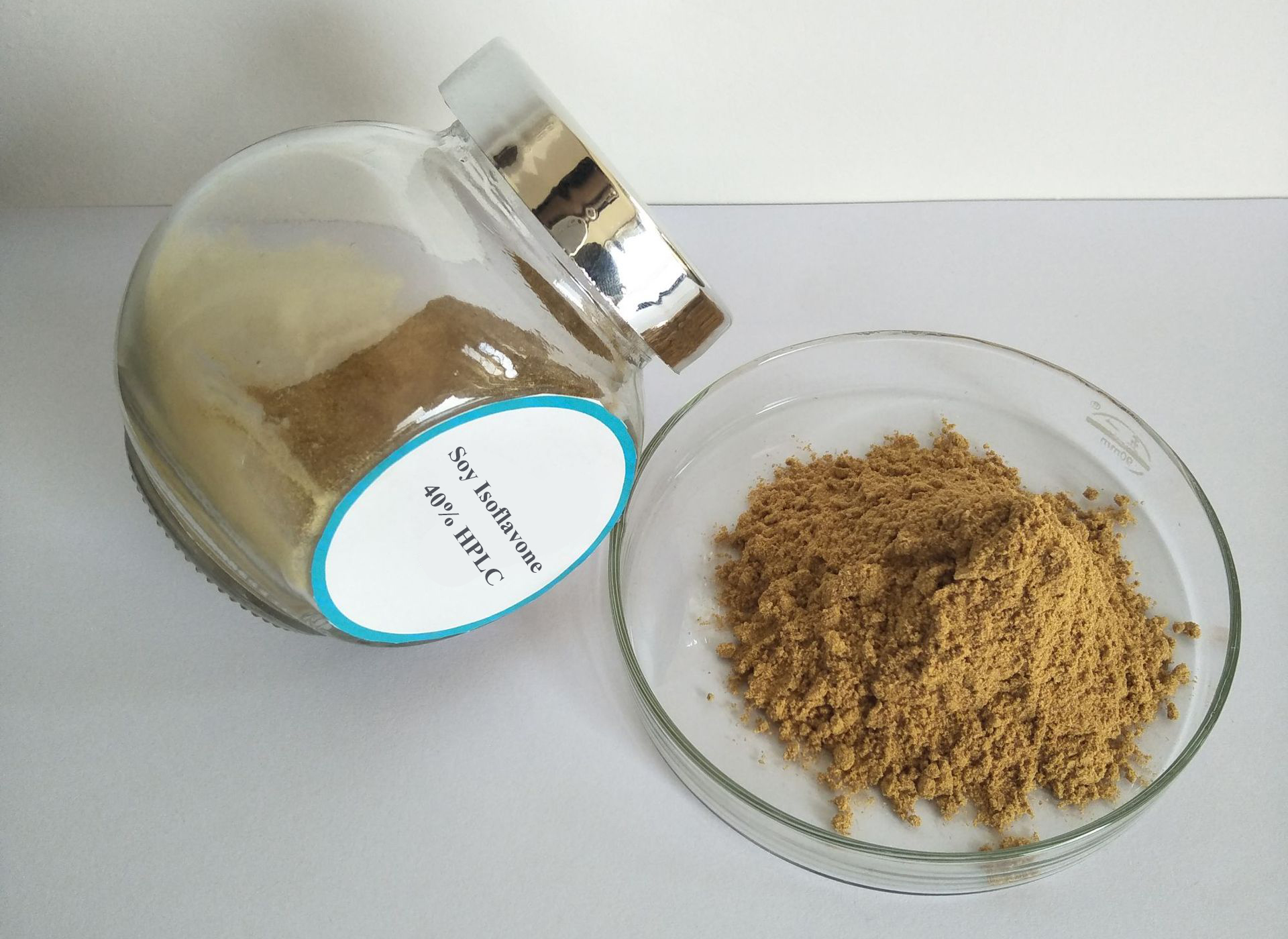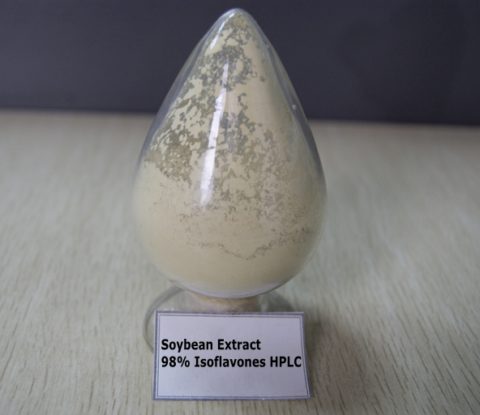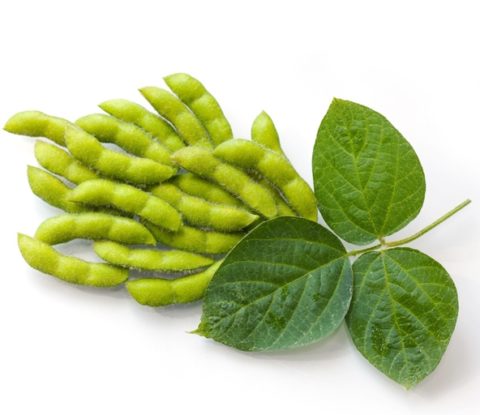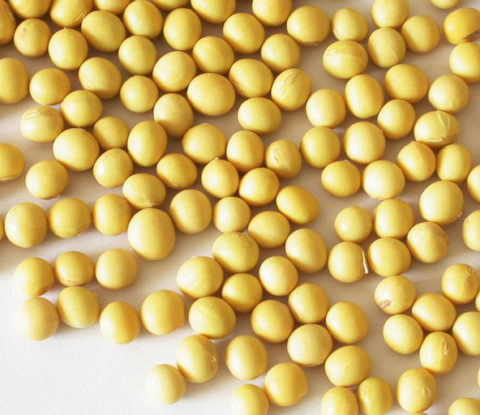
Soy Isoflavone 40%,80% HPLC, Soybean Extract Powder
Soybean extract isoflavone is a kind of flavonoids, a kind of secondary metabolite formed in soybean growth, and a kind of bioactive substance. Soybean isoflavone is also called phytoestrogen because it is extracted from plants and has similar structure with estrogen.
Soybean Extract Powder; Isoflavone40%,80% HPLC
【Latin Name】: Glycine max (L.) Merrill
【Active Ingredient】: Isoflavones/Soy Isoflavones
【Specification】: 40%, 80% Isoflavones
【Testing method】: HPLC
【Part Used】: Seed
【Appearance】: Light yellow fine powder
【Benefits】: Estrogen supplement
【Storage】: Store in cool dry place and keep from direct light
【Shelf life】: 2 years when properly stored
【Packing】: Fiber drum (25kg/drum); aluminum foil bag and carton box(less than 10kg)

Soybean Isoflavone: The soybean (US) or soya bean (UK) (Glycine max) is a species of legume native to East Asia, widely grown for its ediblebean which has numerous uses. The plant is classed as an oilseed rather than a pulse by the UN Food and Agricultural Organization (FAO). Traditional nonfermented food uses of soybeans include soy milk, and from the latter tofu and tofu skin. Fermented foods include soy sauce, fermented bean paste, natto, and tempeh, among others. The oil is used in many industrial applications. The main producers of soy are the United States (35%), Brazil (27%), Argentina (19%), China (6%) and India (4%).The beans contain significant amounts of phytic acid, alpha-linolenic acid, and isoflavones.
Chemical Composition of Soybean
Together, soybean oil and protein content account for about 60% of dry soybeans by weight (protein at 40% and oil at 20%). The remainder consists of 35% carbohydrate and about 5% ash. Soybean cultivars comprise approximately 8% seed coat or hull, 90% cotyledons and 2% hypocotyl axis or germ. Most soy protein is a relatively heat-stable storage protein. This heat stability enables soy food products requiring high temperature cooking, such as tofu, soy milk and textured vegetable protein (soy flour) to be made. The principal soluble carbohydrates of mature soybeans are the disaccharide sucrose (range 2.5–8.2%), the trisaccharide raffinose (0.1–1.0%) composed of one sucrose molecule connected to one molecule of galactose, and the tetrasaccharide stachyose (1.4 to 4.1%) composed of one sucrose connected to two molecules of galactose. While the oligosaccharides raffinose and stachyose protect the viability of the soybean seed from desiccation (see above section on physical characteristics) they are not digestible sugars, so contribute to flatulence and abdominal discomfort in humans and other monogastric animals, comparable to the disaccharide trehalose. Undigested oligosaccharides are broken down in the intestine by native microbes, producing gases such as carbon dioxide, hydrogen, and methane.
Since soluble soy carbohydrates are found in the whey and are broken down during fermentation, soy concentrate, soy protein isolates, tofu, soy sauce, and sprouted soybeans are without flatus activity. On the other hand, there may be some beneficial effects to ingesting oligosaccharides such as raffinose and stachyose, namely, encouraging indigenous bifidobacteria in the colon against putrefactive bacteria. The insoluble carbohydrates in soybeans consist of the complex polysaccharides cellulose, hemicellulose, and pectin. The majority of soybean carbohydrates can be classed as belonging to dietary fiber. Within soybean oil or the lipid portion of the seed is contained four phytosterols: stigmasterol, sitosterol, campesterol,and brassicasterol accounting for about 2.5% of the lipid fraction; and which can be converted into steroid hormones. Saponins, a class of natural surfactants (soaps), are sterols that are present naturally in a wide variety of food-plants: vegetables, legumes, and cereals–ranging from beans and spinach to tomatoes, potatoes and oats. Whole soybeans contain from 0.17 to 6.16% saponins, 0.35 to 2.3% in defatted soy flour and 0.06 to 1.9% in tofu. Legumes such as soybean and chickpeas are the major source of saponins in the human diet. Sources of non-dietary saponins include alfalfa, sunflower, herbs and barbasco. Soy contains isoflavones like genistein and daidzein. It also contains glycitein, an O-methylated isoflavone which accounts for 5–10% of the total isoflavones in soy food products. Glycitein is a phytoestrogen with weak estrogenic activity, comparable to that of the other soy isoflavones.
Introduction of Soybean Isoflavone
For more than five thousand years China has been using soybeans as an additional nitrogen supplement for soil during crop rotation. Found in many East Asian and Hawaiian dishes, green baby soybeans are commonly known as edamame (Japanese for twig bean) or as maodou (Chinese for hairy bean).Brought to America in the 1930s, soybeans have proved to be useful in a variety of ways. Soy products are derived from soybeans that are labeled as field or vegetable types. Also classified as oil, field types are generally grown to produce soy oil. High in Omega fatty acids, soy is also used in feed for livestock and fowl. Vegetable soybeans known as garden types are higher in protein than field types and are used to produce soy milk, tofu, and other soy based food products. It is important to cook the beans before use -they cannot be eaten raw. Soy is used to make a wide range of vegan and vegetarian products like soy vegetable oil, soy milk, soy lecithin, and tofu. Miso, soy sauce, and tempeh, are some fermented food products made from soy. Textured vegetable protein is made from fat free soy flour that can be used as a meat substitute to make high protein, fat free meals.
Processed soy is used in various dairy free products such as ice cream, cheese, yogurt, milk, cream cheese, and margarine. Although they are high in protein, soy based dairy products do not contain large amounts of calcium. To manufacture products like sprouted soybeans, tofu, soy concentrate, or soy protein isolates, dissoluble soy carbohydrates are broken down as the whey ferments. For babies who may be allergic to the proteins in pasteurized cows milk, or for vegetarian and vegan families, soy companies offer soy based infant formulas that the Food and Drug Administration have concluded as safe to use for sole or supplemental nutrition. Soy based infant formulas should not be used if there is an indication of food allergies.
The United States Food and Drug Administration declares that supplemental vitamin products must have a source of full protein. Full, or complete protein contains adequate amounts of essential amino acids that is required by the human body. Soy products offer complete protein for those who would like to replace or reduce their consumption of meat. Animal based food products are high in protein, but are also very high in saturated fat. Soy products offer high protein with no fat.Since 1990, protein quality has been measured by The Protein Digestibility Corrected Amino Acid Score. Their primary focus is the evaluation of protein quality according to human amino acid requirements, and how well they can be digested. According to score criteria, soy protein products are nutritionally equivalent to eggs and meat, and includes casein, which promotes health and human growth. Concentrated soy protein absorbs nearly all of the fiber from the initial soybean. Soy’s high protein content makes it an extensively used ingredient for manufactured cereals and baked goods, and for protein powders and beverage drinks. Not only high in protein, soy based products offer other healthy benefits such as Omega-3 fatty acids that contribute to numerous body actions, and isoflavones that are considered useful in the prevention of prostate, uterine and breast cancer. There is still some medical doubt regarding isoflavones ability to prevent any type of cancer.
Soy is rich in isoflavones, which are the most active phytoestrogens in the human diet. These may help to relieve menopausal symptoms. After the menopause, the level of oestrogen in a woman’s body falls and it is thought that phytoestrogens may provide a substitute for the body’s own oestrogen, relieving symptoms such as hot flushes and dry skin. The interest in phytoestrogens has developed because of the evidence that women in Japan and Asia who consume diets rich in these compounds, do not appear to suffer the same way with hot flushes and sweats as in the western world. In these countries, the diet is rich in soya containing foods, and menopausal symptoms are reported much less. Amongst the main phytoestrogens in the human diet are the isoflavones, which are found primarily in legume type plants such as soya. Phytoestrogens can be consumed by purely increasing dietary intake, but this involves eating large amounts of legume food plants, such as peas and beans, with variable phytoestrogen content. Supplements of Soya Isoflavones are a convenient alternative. Cholesterol reduction is another healthful advantage that comes with soy protein and soy based foods. Diets high in cholesterol and saturated fats are primary targets for heart disease. Fat free textured vegetable protein and processed soy products contain no added cholesterol or saturated fat.
Health Benefits of Soybean Extract Isoflavone
Lunasin
Lunasin is a peptide found in soy and some cereal grains and has been the subject of research since 1996 focusing on cancer, cholesterol and cardiovascular disease and inflammation.
Cancer
According to the American Cancer Society, “Studies in humans have not shown harm from eating soy foods. Moderate consumption of soy foods appears safe for both breast cancer survivors and the general population, and may even lower breast cancer risk.” They caution however that soy supplements should be avoided.
Brain
Recent studies have shown improvement in postmenopausal women’s cognitive function, particularly verbal memory, and in frontal lobe function with the use of soy supplements.
Natural phenols
Isoflavones
Soybeans also contain the isoflavones genistein and daidzein, types of phytoestrogen, that are considered by some dietitians and physicians to be useful in the prevention of cancer and by others to be carcinogenic[112] and endocrine disruptive. Soy’s content of isoflavones are as much as 3 mg/g dry weight. Isoflavones are polyphenol compounds, produced primarily by beans and other legumes, including peanuts and chickpeas. Isoflavones are closely related to the antioxidant flavonoids found in other plants, vegetables and flowers. Isoflavones such as genistein and daidzein are found in only some plant families, because most plants do not have an enzyme, chalcone isomerase which converts a flavone precursor into an isoflavone. In contradiction to well known benefits of isoflavones, genistein acts as an oxidant (stimulating nitrate synthesis), and blocks formation of new blood vessels (antiangiogenic effect). Some studies show that genistein acts as inhibitor of substances that regulate cell division and cell survival (growth factors). A review of the available studies by the United States Health and Human Services Agency for Healthcare Research and Quality (AHRQ) found little evidence of substantial health improvements and no adverse effects, but also noted that there was no long-term safety data on estrogenic effects from soy consumption.
Glyceollins
Glyceollins are molecules belonging to the pterocarpans family. They are also found in the soybean and have been found to have an antifungal activity against Aspergillus sojae, the fungal ferment used to produce soy sauce. They are phytoalexins with an antiestrogenic activity.
Cholesterol and heart diseases
The dramatic increase in soyfood sales is largely credited to the Food and Drug Administration’s (FDA) approval of soy as an official cholesterol-lowering food, along with other heart and health benefits. A 2001 literature review argued that these health benefits were poorly supported by the available evidence, and noted that disturbing data on soy’s effect on the cognitive function of the elderly existed. In 2008, an epidemiological study of 719 Indonesian elderly found that tofu intake was associated with worse memory, but tempeh (a fermented soy product) intake was associated with better memory. This study replicated other studies.
In 1995, the New England Journal of Medicine (Vol. 333, No. 5) published “Meta-analysis of the effects of soy protein intake on serum lipids”, financed in part by DuPont Protein Technologies International (PTI), which produces and markets soy through The Solae Company (see external links). The meta-analysis concluded that soy protein is correlated with significant decreases in serum cholesterol, LDL (bad cholesterol) and triglycerides. However, HDL (good cholesterol) did not increase by a significant amount. Soy phytoestrogens (isoflavones: genistein and daidzein) adsorbed onto the soy protein were suggested as the agent reducing serum cholesterol levels. On the basis of this research PTI filed a petition with FDA in 1998 for a health claim that soy protein may reduce cholesterol and the risk of heart disease. The FDA granted the following health claim for soy: “25 grams of soy protein a day, as part of a diet low in saturated fat and cholesterol, may reduce the risk of heart disease.” One serving, (1 cup or 240 mL) of soy milk, for instance, contains 6 or 7 grams of soy protein. Solae resubmitted their original petition, asking for a more vague health claim, after their original was challenged and highly criticized. Solae also submitted a petition for a health claim that soy can help prevent cancer. They quickly withdrew the petition for lack of evidence and after more than 1,000 letters of protest were received. On February 18, 2008 Weston A. Price Foundation submitted a petition for removal of this health claim. 25 g/day soy protein was established as the threshold intake because most trials used at least this much protein and not because less than this amount is inefficacious. In fact, there is evidence suggesting that lower amounts are indeed efficacious.
An American Heart Association review of a decade long study of soy protein benefits casts doubt on the FDA allowed “Heart Healthy” claim for soy protein and does not recommend isoflavone supplementation. The review panel also found that soy isoflavones have not been shown to reduce post menopause “hot flashes” in women and the efficacy and safety of isoflavones to help prevent cancers of the breast, uterus or prostate is in question. However, AHA concludes that “many soy products should be beneficial to cardiovascular and overall health because of their high content of polyunsaturated fats, fiber, vitamins, and minerals and low content of saturated fat”.
Importantly, however, the AHA did not conduct a formal statistical analysis of the 22 studies upon which they based their estimate of the potency of soy protein. When such an analysis was conducted, Jenkins et al. found that the AHA had considerably underestimated the hypocholesterolemic effects of soy protein. Further, when the analysis was limited to the 11 studies that provided evidence that the control and soy diets were matched, soy protein was found to lower LDL by 5.2 percent. This estimate is in line with the results of other recently published meta-analyses. Furthermore, recent research suggests that soy protein decreases postprandial triglyceride levels, which is increasingly viewed as important for reducing CHD risk.
Phytic acid
Soybeans contain a high level of phytic acid, which has many effects including acting as an antioxidant and a chelating agent. The beneficial claims for phytic acid include reducing cancer,minimizing diabetes, and reducing inflammation. However, phytic acid is also criticized for reducing vital minerals due to its chelating effect, especially for diets already low in minerals.
Health Risks of Soybean Extract Isoflavone
Allergy
Allergy to soy is common, and the food is listed with other foods that commonly cause allergy, such as milk, eggs, peanuts, tree nuts, shellfish. The problem has been reported among younger children, and the diagnosis of soy allergy is often based on symptoms reported by parents and results of skin tests or blood tests for allergy. Only a few reported studies have attempted to confirm allergy to soy by direct challenge with the food under controlled conditions.[135] It is very difficult to give a reliable estimate of the true prevalence of soy allergy in the general population. To the extent that it does exist, soy allergy may cause cases of urticaria and angioedema, usually within minutes to hours of ingestion. In rare cases, true anaphylaxis may also occur. The reason for the discrepancy is likely that soy proteins, the causative factor in allergy, are far less potent at triggering allergy symptoms than the proteins of peanut and shellfish.[136] An allergy test that is positive demonstrates that the immune system has formed IgE antibodies to soy proteins. However, this is only a factor when soy proteins reach the blood without being digested, in sufficient quantities to reach a threshold to provoke actual symptoms.
Soy can also trigger symptoms via food intolerance, a situation where no allergic mechanism can be proven. One scenario is seen in very young infants who have vomiting and diarrhoea when fed soy-based formula, which resolves when the formula is withdrawn. Older infants can suffer a more severe disorder with vomiting, diarrhoea that may be bloody, anemia, weight loss and failure to thrive. The most common cause of this unusual disorder is a sensitivity to cow’s milk, but soy formulas can also be the trigger. The precise mechanism is unclear and it could be immunologic, although not through the IgE-type antibodies that have the leading role in urticaria and anaphylaxis. However it is also self-limiting and will often disappear in the toddler years.
Phytoestrogen
Soybeans contain isoflavones called genistein and daidzein, which are one source of phytoestrogens in the human diet. Because most naturally occurring estrogenic substances show weak activity, normal consumption of foods that contain these phytoestrogens should not provide sufficient amounts to elicit a physiological response in humans.
Plant lignans associated with high fiber foods such as cereal brans and beans are the principal precursor to mammalian lignans which have an ability to bind to human estrogen sites. Soybeans are a significant source of mammalian lignan precursor secoisolariciresinol containing 13–273 µg/100 g dry weight. Another phytoestrogen in the human diet with estrogen activity is coumestans, which are found in beans, split-peas, with the best sources being alfalfa, clover, and soybean sprouts. Coumestrol, an isoflavone coumarin derivative is the only coumestan in foods.
Soybeans and processed soy foods are among the richest foods in total phytoestrogens (wet basis per 100g), which are present primarily in the form of the isoflavones daidzein and genistein. When compared to human breast fed or cow milk formula fed diets, which contain isoflavone levels of 0.005-0.01 mg/day, soy-based infant formulas contain isoflavone levels of 6–47 mg/day that constitute several orders of magnitude greater than they receive from other sources of nutrition.
Animals
Although animals cannot be used as a proxy for human cellular biology, numerous studies have shown that high levels of phytoestrogen intake during neonatal to postnatal periods produce serious detrimental effects in the health of male animals, particularly in the growth and viability of the genitals.
Women
A 2001 literature review suggested that women with current or past breast cancer should be aware of the risks of potential tumor growth when taking soy products, based on the effect of phytoestrogens to promote breast cancer cell growth in animals. A 2006 commentary reviewed the relationship with soy and breast cancer. They stated that soy may decrease the risk of breast cancer, but cautioned that the impact of isoflavones on breast tissue needs to be evaluated at the cellular level in women at high risk for breast cancer. A high consumption of omega-6 polyunsaturated fatty acids, which are found in most types of vegetable oil including soybean oil, may increase the likelihood that postmenopausal women will develop breast cancer. Another analysis suggests an inverse association between total polyunsaturated fatty acids and breast cancer risk. A 2011 analysis of the literature said: “Our study suggests soy isoflavones intake is associated with a significant reduced risk of breast cancer incidence in Asian populations, but not in Western populations.” In a recent (August 2011) trial the daily administration of tablets containing 200 mg of soy isoflavones for 2 years did not prevent bone loss or menopausal symptoms.
Men
Because of the phytoestrogen content, some studies have suggested that soybean ingestion may influence testosterone levels in men. However, a 2010 meta-analysis of 15 placebo controlled studies showed that neither soy foods nor isoflavone supplements alter measures of bioavailable testosterone or estrogen concentrations in men. It has been hypothesized that soy foods and enterolactone may increase the development of prostate cancer although no significant associations were observed for the soy isoflavones. Furthermore, soy consumption has been shown to have no effect on the levels and quality of sperm. A 2009 meta-analysis of the research on the association between soy consumption and prostate cancer risk in men concluded that “consumption of soy foods is associated with a reduction in prostate cancer risk in men.”
Brain
Though there is some evidence that estrogen can help protect and repair the brain after injury in rats, there is also evidence that phytoestrogens may be harmful for the recovery of rats in other situations that have sustained brain injury. Similarly, epidemiological evidence of humans eating soya products is currently divided: a study of Japanese men between 1965 and 1999 demonstrated a positive correlation between brain atrophy and consumption of tofu meals, and a study on elderly Indonesian men and women found that high tofu intake was associated with poorer memory, but the consumption of tempeh was associated with better memory. So it may be that the type of soya bean used, or its preparation or additional ingredients are relevant factors, there is not yet definitive evidence known.
Carcinogenicity
Though raw soy flour is known to cause pancreatic cancer in rats the cooked flour has not been found carcinogenic. Whether soy might promote pancreatic cancer in humans is unknown because studies have not yet attempted to single out soy intake and the incidence of pancreatic cancer in humans, and the amount of soy fed to the rats is proportionately far larger than what humans would normally consume. However, the soy isoflavone genistein has been suggested as a chemopreventive agent against pancreatic cancer, by interfering with the chemical pathways that promote the creation and growth of tumors.
The Cancer Council of New South Wales, Australia has released a statement saying scientific research suggests that overall the moderate consumption of soy products does not appear to present a risk to women with breast cancer, and there is equivocal evidence that consuming large amounts of soy products may have a protective effect against developing breast and prostate cancer. However, the Council does not recommend taking soy dietary supplements as there is no evidence they are either effective or safe at preventing or treating cancers.
Gout
Soybeans and soy products contain significant amounts of purines, a class of organic compounds. For people who suffer from gout, eating foods containing moderate or high levels of purines may make the condition worse. The U.S. National Institutes of Health (NIH) recommends that gout sufferers limit consumption of soy products (although also suggesting that soy may have health benefits by reducing the risk for heart disease).However, other researchers have found little or no association between consumption of purine-rich vegetables (including beans) and gout.






